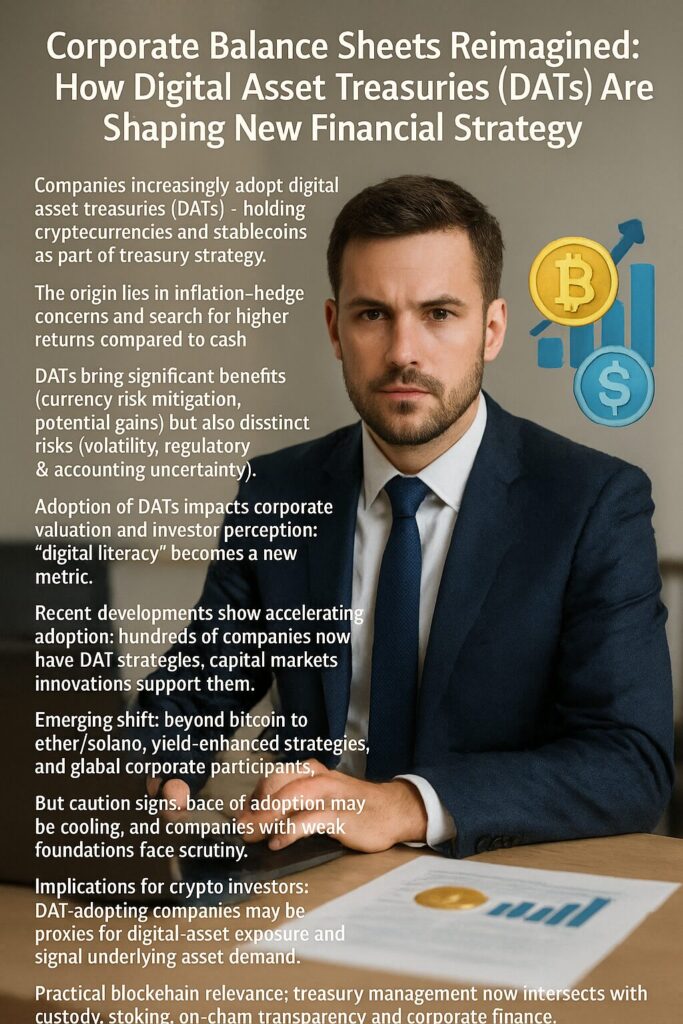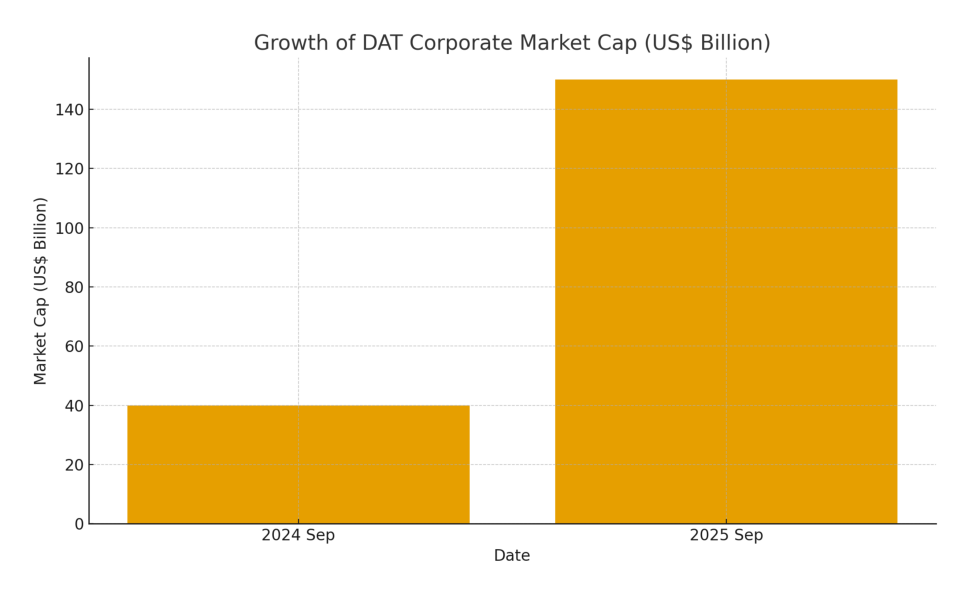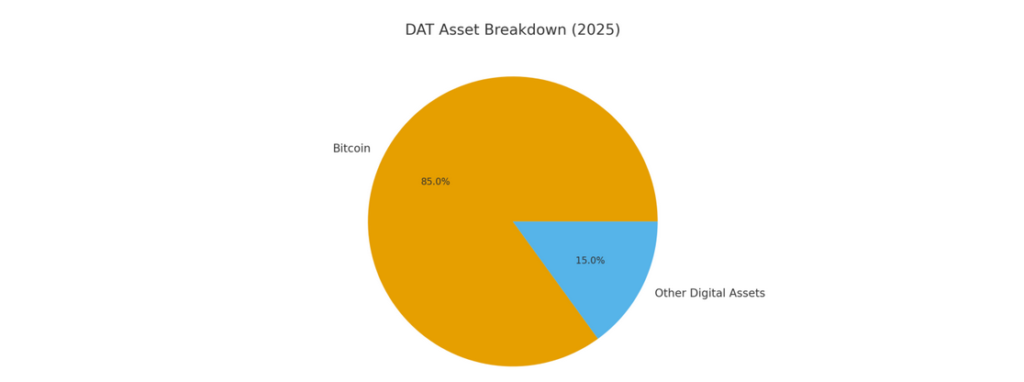
Main Points :
- Companies increasingly adopt digital asset treasuries (DATs) — holding cryptocurrencies and stablecoins as part of treasury strategy.
- The origin lies in inflation-hedge concerns and search for higher returns compared to cash reserves.
- DATs bring significant benefits (currency risk mitigation, potential gains) but also distinct risks (volatility, regulatory & accounting uncertainty).
- Adoption of DATs impacts corporate valuation and investor perception: “digital literacy” becomes a new metric.
- Recent developments show accelerating adoption: hundreds of companies now have DAT strategies, capital markets innovations support them.
- Emerging shift: beyond bitcoin to ether/solana, yield-enhanced strategies, and global corporate participants.
- But caution signs: pace of adoption may be cooling, and companies with weak foundations face scrutiny.
- Implications for crypto investors: DAT-adopting companies may be proxies for digital-asset exposure and signal underlying asset demand.
- Practical blockchain relevance: treasury management now intersects with custody, staking, on-chain transparency and corporate finance.
- Conclusion: DATs represent a paradigm shift—from defensive cash holdings to proactive digital-asset management—and investors and practitioners should monitor both structural tailwinds and risks.
1: Origin and Evolution of Digital Asset Treasuries
From Cash Piles to Crypto Reserves
Corporate treasury management has historically prioritized cash and short-term safe instruments. In an era of very low or negative interest rates, coupled with inflationary pressures and currency devaluation concerns, many corporations began to question the efficacy of large idle cash reserves. The concept of a Digital Asset Treasury (DAT) emerged in this context as companies started allocating a portion of the balance sheet to cryptocurrencies (e.g., Bitcoin) and stablecoins, not merely as speculative holdings but as strategic reserve assets.
The impetus was two-fold: first, to hedge against inflation and fiat currency dilution; second, to capture potential capital gains from the strongly rising crypto markets. The original article highlights this shift: DATs began as a mechanism for inflation hedging and capital gain acquisition.
Indeed, research shows that since 2021 only a handful of companies held bitcoin in their treasuries, but by September 2025 more than 200 companies globally reported adopting DAT strategies, with over 190 focused on bitcoin and another 10–20 on other digital assets, cumulatively estimated to hold over US $115 billion in digital assets.
From the traditional “cash-centric” corporate finance mindset, the evolution of DATs represents a paradigm shift: moving from purely defensive capital preservation toward a hybrid model of defence (hedging) and offence (growth). The original article puts it succinctly: the shift is from (defensive finance) to (finance combining offence and defence).
In short, DATs reflect how modern corporations are re-thinking their treasury strategies in the digital era, where idle cash is seen not merely as safe, but potentially unproductive in an inflationary environment.
2: Benefits and Risks — the Two Sides of the Coin
Opportunity Meets Uncertainty
Adopting a Digital Asset Treasury offers meaningful advantages—yet also introduces unique risks which corporate finance functions must manage carefully.
Benefits
- Inflation and fiat-currency risk mitigation: By allocating part of reserves into cryptocurrencies, corporations seek to protect purchasing power of treasury assets. The article emphasises this as a core origin.
- High return potential: Cryptocurrencies have exhibited significant appreciation over recent years, offering upside beyond traditional cash or low-yield bonds.
- Signalling effect: Firms that adopt DATs send a message of forward-thinking and digital readiness, potentially enhancing investor perception (addressed further in Section 3).
- Diversification: A digital-asset allocation may broaden treasury portfolio beyond classic fixed-income and cash equivalents.
Risks
- High price volatility: Cryptocurrencies are by nature volatile, meaning large unrealised gains—or losses—can appear on corporate balance sheets, impacting earnings and investor perception. The article notes that companies may record significant valuation losses during quarterly results.
- Regulatory and accounting uncertainty: Digital-asset regulation varies widely by jurisdiction; accounting treatment (e.g., fair-value vs cost basis) may also be evolving. For example, a 2023 update by Financial Accounting Standards Board (FASB) allowed fair-value treatment of digital assets for certain companies.
- Custody and security risk: Holding sizeable digital assets imposes demands on cyber-security, selection of custodians, and operational risk management—not typical for traditional treasuries. The article stresses that mere ownership isn’t enough: success depends on new risk-management frameworks and specialist skills.
- Liquidity and exit risk: Depending on the asset and market conditions, exiting large holdings may be challenging. Moreover, capital-markets structures used to fund DATs (e.g., convertible notes) may carry additional obligations.
- Corporate strategy dilution: If a company pivots its identity solely to accumulate digital assets (rather than operating its core business), it risks losing strategic focus and investor comprehension.
In adopting DATs, the article argues, corporate treasury departments must develop new expertise—familiarity with digital-asset markets, blockchain infrastructure, regulatory regimes and capital-markets instruments. This represents a material shift in the required skill set for finance and treasury functions.
3: Impact on Corporate Valuation — Investors Evaluating “Digital Literacy”
The New Investor Metric
The adoption of digital asset treasuries does not only affect treasury management—it influences how investors assess companies. The article introduces the concept of “digital literacy” and risk-tolerance as part of corporate valuation. In other words, investors now look beyond traditional metrics (cash flows, earnings, debt) and consider whether a company has the capability and governance to manage digital-assets competently.
Firms that hold digital assets on the balance sheet send a signal to the market: they are active in seeking new growth avenues, have exposure to the digital-asset ecosystem, and may be better positioned for macro headwinds such as inflation or currency weakness. In turn, their valuation might command a premium. For example, the article notes that companies introducing DAT strategies might be seen as “先進的な企業” (advanced companies) by investors.
The investor lens includes specific indicators such as:
- The proportion of the balance sheet allocated to digital assets (e.g., percent of reserves held in crypto)
- The transparency of digital-asset holdings (disclosure of volumes, custodians, audit)
- The governance and risk-management framework for digital holdings
- The corporate strategy linking digital holdings to business purpose, rather than mere speculation
Indeed, empirical research supports this. An academic paper tracking firms that adopted bitcoin treasury strategies found their share price returns co-moved with bitcoin returns (average beta ~0.62) and in some firms even above 1. Another survey shows that by 2025 the market valuation of “DAT companies” had grown more than threefold—moving from about US $40 billion in September 2024 to around US $150 billion by September 2025.
For the reader interested in new crypto assets and income opportunities, DAT-adopting corporations represent another channel of exposure—via equity rather than direct token investment—but understanding the corporate structure and risk is essential.
4: Recent Developments and Trends
What’s New in the DAT Landscape
1.Acceleration of corporate adoption
As of September 2025, more than 200 companies reported DAT strategies, holding collectively over US $115 billion in digital assets. Capital-markets instruments such as PIPEs, convertible notes, de-SPACs and ATM programs are playing key roles in financing digital-asset accumulation.

2. Beyond bitcoin — diversification into Ether, Solana, yield strategies
While bitcoin remains dominant, an increasing number of companies are targeting other protocols that enable staking, DeFi or yield-generation (e.g., Ethereum, Solana). For example, firms like SharpLink Gaming and BitMine have adopted treasury strategies centred on these assets.

3. Global participation and cross-border players
Not only U.S. firms but also companies in Japan (e.g., Metaplanet Inc.) and other markets are embracing the DAT model. For instance, Metaplanet pivoted from its hotel business to Bitcoin accumulation and raised large funding via Japanese stock-warrant issuance.
4. Capital markets innovation around DATs
Treasury strategies are no longer simple “buy bitcoin with cash” moves. They involve structured funding: convertible debt secured by digital assets, warrants, equity lines, ATM programs and preferred shares. These instruments align corporate finance, treasury and digital-asset strategy in one.
5. A potential cooling of the trend and consolidation
More recently, signs of moderation have appeared. Reports suggest that corporate purchases of bitcoin turned lower by September 2025, and some DAT-companies are trading below the net asset value (NAV) of their holdings. This suggests that while the tailwind remains, selection matters increasingly, and companies with weak governance or speculative drives may face headwinds.
6. Relevance for crypto practitioners and investors
For those seeking new crypto assets or yield sources, DAT-companies represent an indirect route: companies holding crypto on their balance sheet may help drive demand, supply shock or ecosystem development. They also raise questions about custody infrastructure, staking delegation, tokenomics and corporate disclosures—all practical blockchain issues.
In sum, the DAT landscape is maturing—expanding drivers, diversifying strategies—but also entering a phase where scrutiny, discipline and differentiation will matter more.
*Insert here: Figure 1 (bar-chart) showing growth of DAT corporate market cap from US $40 billion (Sept 2024) to US $150 billion (Sept 2025).
*Insert here: Figure 2 (pie-chart) showing asset breakdown (bitcoin vs alt-crypto) among DATs as of 2025.
5: Why This Matters for Crypto Investors and Blockchain Practitioners
From Theory to Practice
For the reader who is actively exploring new crypto assets, seeking revenue opportunities, or working on blockchain-based applications (such as your wallet development or token launch), understanding DATs can yield actionable insights:
- Demand side of crypto ecosystem: When corporates accumulate digital assets as treasury reserves, this adds a structural demand driver. If many firms increase holdings, token supply to the market may tighten, which could impact price dynamics.
- Indirect exposure vehicle: Instead of buying tokens directly, one might invest in or monitor companies with DAT strategies—equity exposure to the crypto asset class via corporate balance sheets. Of course, equity brings different risk/return profiles.
- Staking and yield implications: As companies diversify into alt-crypto with staking or yield strategies, this emphasises operational infrastructure: custody, validator nodes, on-chain participation. For a wallet developer or blockchain-app builder, this offers reference points for enterprise usage of staking services, custody modules, treasury dashboards.
- Disclosure and transparency trends: Corporate finance teams with DATs increasingly integrate blockchain-native metrics (e.g., number of tokens held, acquisition cost, staking yield, NAV premium). This suggests that blockchain-based transparency may shift from purely decentralised protocols into the enterprise world.
- Tokenomics and ecosystem alignment: If platforms see adoption by corporates holding tokens for treasury, this may influence tokenomics (e.g., circulating supply, staking rewards, governance alignment). It could inform how you design your token or wallet functionalities.
- Risk management best practices: For your wallet or application (e.g., non-custodial swap wallet), it’s useful to see how corporates address custody risk, value volatility, regulatory compliance—and effort you may replicate or learn from in infrastructure design.
Therefore, while DATs are corporate finance phenomena, they have practical relevance for anyone active in the crypto space.
6: Looking Ahead — Key Questions and Strategic Implications
What to Watch and How to Position
As the DAT movement matures, several strategic questions emerge. For companies, investors and blockchain practitioners alike, the following dimensions merit focus:
- Differentiation among DAT firms: As noted in academic research, companies will diverge based on scale of holdings, governance quality, capital-markets funding structure, and whether they build proprietary infrastructure (e.g., staking platforms).
- Asset diversification beyond Bitcoin: Will more firms allocate into tokens beyond bitcoin—Ethereum, Solana, staking protocols—and how will that impact risk/return profiles?
- Liquidity and exit dynamics: Firms holding large digital-asset reserves must manage exit strategies and market impact of large disposals.
- Regulatory and accounting evolution: As digital assets become more embedded in corporate finance, further accounting standards, tax regimes and regulatory frameworks will evolve.
- Operational infrastructure maturity: Custody solutions, cyber-security, token analytics, on-chain auditing, treasury dashboards—all form part of the “professionalised” DAT ecosystem.
- Investor sentiment cycle: The enthusiasm cycle may moderate. Reports indicate corporate crypto buying already slowed in late 2025 and some stocks trade below NAV. Firms that merely adopted the label may lose investor favour unless they demonstrate execution and governance.
- Implications for token & wallet ecosystems: Growing corporate holdings may influence token supply and market behaviour, while wallet developers may find enterprise use-cases for treasury dashboards, institutional wallets, custody services, on-chain analytics.
In practice, for someone building a wallet (e.g., your “dzilla Wallet”) with swap functionality and enterprise/treasury use-cases, the DAT trend signals that corporates are thinking of crypto not just as trading assets but as strategic reserves. This offers a potential market: treasury-grade wallet solutions, institutional staking dashboards, transparency modules. At the same time, risk awareness (volatility, regulatory) must feed into UX/UI — e.g., transparency of provenance, real-time valuation, swap-risk warnings.
Conclusion
Digital Asset Treasuries (DATs) represent a significant shift in corporate finance: firms are increasingly treating cryptocurrencies and stablecoins as part of their balance-sheet strategy—not just for trading but for reserves, hedging, growth. This movement originates from macro pressures (inflation, currency risk, low yield), has clear appeal (diversification, upside, signalling), but also comes with distinctive risks (volatility, regulatory, liquidity, governance). Investor perception is shifting: “digital literacy” and ability to manage digital assets competently now forms part of corporate valuation. The recent surge in DAT adoption, capital-markets innovation and expansion into alt‐crypto and yield strategies underscore the maturation of the space—but a degree of caution is now warranted as the trend faces selection and execution challenges.
For crypto investors and blockchain-practitioners, DATs are more than an interesting trend: they present an indirect exposure channel, influence tokenomics and on-chain demand, and highlight operational infrastructure requirements (custody, staking, dashboards) that overlap with wallet and token-application design. As you build your “dzilla Wallet” or evaluate new token ecosystems, consider how corporate adoption of digital assets might shape supply, demand, investor behaviour and infrastructure standards.
In short: DATs are not just a footnote—they may be a core part of how the digital-asset economy internalises into traditional finance. The question now is not whether companies will adopt DATs, but which companies will do so well, and how practitioners can build the infrastructure that supports this new form of treasury.

